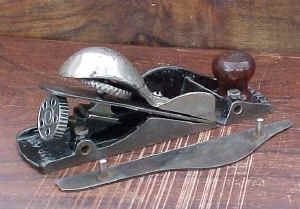
Stanley No 140 (Early Type 2) with side removed6
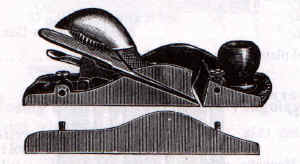
1898 Catalog Image of Stanley No 140 Showing Lever Adjustment
for Cutter 2
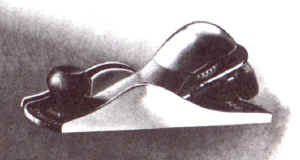
1909 Catalog Image of Stanley No 140 Showing Screw Adjustment
for Cutter 3
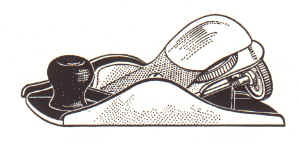
1923 Catalog Image of Stanley No 140 4
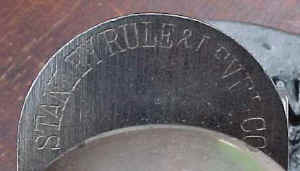
Early "Stanley Rule & Level Co." Cutter Mark6
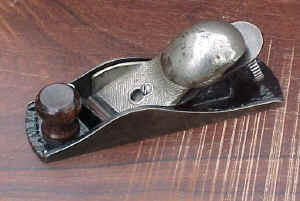
Stanley No 140 Rabbet (Type II)6
Manufactured1: 1885 to 1943
Patent1: 528,829 - Traut's 11/6/1894 (basic patent), Traut's 3/13/1900 (cutter adjustment)
Dimensions1: 7 inches long
Cutter1: 1-3/4 inch wide
Construction1: Cast iron., rosewood knob
Finish1: Japanned, nickel plated cap and screws
User Info1: Special purpose block plane, where the use of the skewed cutter and/or rabbet is required. Preferred by some for use on cross-grained hardwoods due to the skew of the cutter.
Average Price1: $75 to $150
Type 11: $150 to $250 (1895 to 1898)
Notes1: Steel side plate detaches, converting this block plane into a rabbet plane. Type 1 has lever cutter adjustment and "Stanley Rule & level Co." trademark on cutter. Traut's 11/6/1894 patent date on the side plate.

Early November 6, 1894 Patent Date6
Type 2 and later have screw adjust for cutter, early Type 2 models retain the patent
date on the side plate. The orginal screws used to secure the side plate to the body are
often missing. The original screws were always flat on top; the earlier types had knurling
around the edges. Round top screws were never used.
Sharpening5: The blade is sharpened in essentially
the same manner as skew chisels. The need to maintain an accurate skew angle is paramount
in a plane such as the No 140, because there is very little room to move the blade
laterally on the bed in order to adjust for any errors in sharpening angle. In addition,
the blade must be flush with the edge of the body to perform the rabbeting function
properly. Since the plane has a bevel-up blade, the blade is sharpened at the lowest angle
consistent with the wood being worked.
Sources: 1. Walter, John . "Antique &
Collectable Stanley Tools, Guide to Identity and Value", 2nd Edition, 1996
2. The Stanley Catalog Collection, 1855 to 1898, The Astragal Press, Mendham, New Jersey
3. Wood, Jack P. "Early 20th Century Stanley Tools, Price Guide". Contains
reprints of the 1909 and 1926 Stanley Works Tool Catalogs.
4. Smith, Roger K., Reprint of Stanley Catalog No 120 orginally issued in 1923,
"Carpenters' and Mechanics Tools", The Stanley Rule and & Level Plant, The
Stanley Works, New Britain, Conn., U.S.A.
5. Lee, Leonard, "The Complete Guide to Sharpening",Taunton Press, Inc.,1995
6. Stanley No 140 which is part of the tool collection of Gordon Muster . Fine Condition.
Purchased for $125 from a local tool dealer at a SWTCA meeting in Houston in March of
2001.